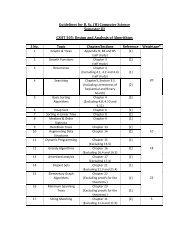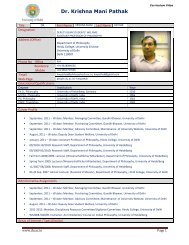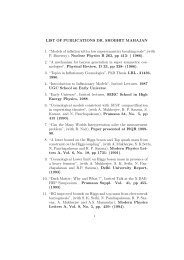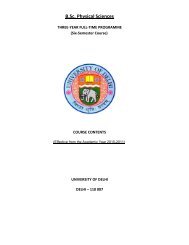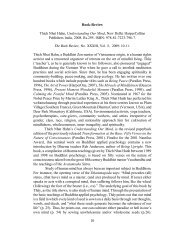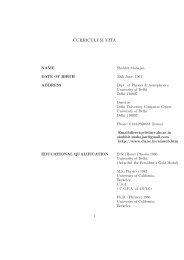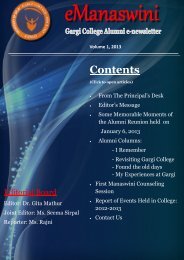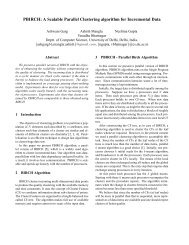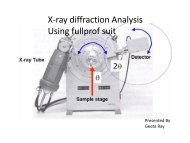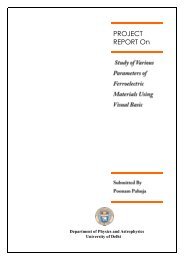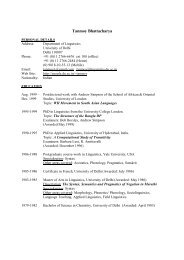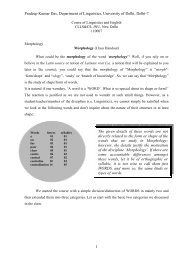Clay illuviation in calcareous soils of the semiarid - Home Pages of ...
Clay illuviation in calcareous soils of the semiarid - Home Pages of ...
Clay illuviation in calcareous soils of the semiarid - Home Pages of ...
You also want an ePaper? Increase the reach of your titles
YUMPU automatically turns print PDFs into web optimized ePapers that Google loves.
184<br />
Peds <strong>of</strong> <strong>the</strong> Bt horizons <strong>of</strong> representative Haplustalf and Natrustalf <strong>of</strong> <strong>the</strong> study area and<br />
benchmark acidic (pH f 5.6) ferrug<strong>in</strong>ous soil <strong>of</strong> sou<strong>the</strong>rn India (Vijayapura series, Oxic<br />
Haplustalf, Murthy et al., 1982) were broken to open <strong>the</strong> fresh surfaces and <strong>the</strong>n fixed on<br />
alum<strong>in</strong>ium stub with LEIT-C conductive cement. The samples were coated with gold, and<br />
exam<strong>in</strong>ed <strong>in</strong> a Philips Scann<strong>in</strong>g Electron Microscope (SEM) to study <strong>the</strong> orientation <strong>of</strong><br />
clay platelets <strong>in</strong> <strong>the</strong> voids.<br />
Particle size distribution was determ<strong>in</strong>ed by <strong>the</strong> <strong>in</strong>ternational pipette method after <strong>the</strong><br />
removal <strong>of</strong> organic matter, CaCO 3 and free iron, alum<strong>in</strong>ium oxides. Sand (2000–50 Am),<br />
silt (50–2 Am), total clay (< 2 Am) and f<strong>in</strong>e clay (< 0.2 Am) fractions were separated by <strong>the</strong><br />
procedure <strong>of</strong> Jackson (1979). Soil pH, electrical conductivity <strong>of</strong> <strong>the</strong> saturation extract<br />
(ECe) and soluble cations and anions <strong>in</strong> <strong>the</strong> saturation extracts were measured by standard<br />
methods (Richards, 1954). Cation exchange capacity (CEC) and exchangeable sodium and<br />
potassium were determ<strong>in</strong>ed follow<strong>in</strong>g <strong>the</strong> method <strong>of</strong> Richards (1954), substitut<strong>in</strong>g 1N<br />
Mg(NO3)2 <strong>of</strong> pH 8.6 for <strong>the</strong> NH4OAc to elim<strong>in</strong>ate <strong>the</strong> <strong>in</strong>fluence <strong>of</strong> zeolites and<br />
feldspathoid m<strong>in</strong>erals (Gupta et al., 1985). Exchangeable calcium and magnesium were<br />
determ<strong>in</strong>ed follow<strong>in</strong>g <strong>the</strong> 1N NaCl solution extraction method <strong>of</strong> Piper (1966).<br />
The silt and clay fractions were subjected to X-ray diffraction (XRD) analyses <strong>of</strong><br />
parallel-oriented slide mounts after Ca- and K-saturation, Ca-glycolation us<strong>in</strong>g ethylene<br />
glycol and heat treatment <strong>of</strong> K-saturated samples at 25, 100, 300 and 550 jC, and also HCl<br />
treatment us<strong>in</strong>g a Philips diffractometer with Ni-filtered CuKa radiation and a scann<strong>in</strong>g<br />
speed <strong>of</strong> 2j 2h per m<strong>in</strong>ute. Semi-quantitative estimates <strong>of</strong> <strong>the</strong> clay m<strong>in</strong>erals were made<br />
follow<strong>in</strong>g <strong>the</strong> pr<strong>in</strong>ciples outl<strong>in</strong>ed by Gjems (1967) and Kapoor (1972).<br />
3. Results<br />
3.1. Micromorphological characteristics<br />
D.K. Pal et al. / Geoderma 115 (2003) 177–192<br />
The detailed micromorphology <strong>of</strong> <strong>soils</strong> with regard to clay ped<strong>of</strong>eatures were recorded,<br />
as this method is <strong>the</strong> best for identify<strong>in</strong>g illuvial clay (Bullock and Thompson, 1985). Soils<br />
<strong>of</strong> <strong>the</strong> present study have developed subangular blocky microstructure with channel and<br />
vughs (Fig. 2a). In <strong>the</strong> B horizons, <strong>the</strong> percentage <strong>of</strong> coarse m<strong>in</strong>eral gra<strong>in</strong>s decreases and<br />
that <strong>of</strong> f<strong>in</strong>e fraction <strong>in</strong>creases. The relative distribution pattern is open porphyric. The<br />
coarse fraction consists <strong>of</strong> quartz, biotite, muscovite, feldspars and heavy m<strong>in</strong>erals. The<br />
f<strong>in</strong>e fraction (< 20 Am) is micaceous with micrite crystals at places. The pores are<br />
Fig. 4. Representative scann<strong>in</strong>g electron microscopic features <strong>of</strong> illuvial clay <strong>in</strong> <strong>soils</strong> <strong>of</strong> <strong>the</strong> Gangetic Pla<strong>in</strong>s along<br />
with petrographic and SEM features <strong>of</strong> ferrug<strong>in</strong>ous <strong>soils</strong> <strong>of</strong> sou<strong>the</strong>rn India. (a) Full view <strong>of</strong> illuvial clay<br />
ped<strong>of</strong>eature along a void, Pedon 13, Sitapur, 38–84 cm, (b) expanded part <strong>of</strong> <strong>the</strong> same show<strong>in</strong>g poorly oriented<br />
clay platelets, (c) optical photomicrograph <strong>in</strong> cross-polarized light <strong>of</strong> strongly oriented void argillan from<br />
ferrug<strong>in</strong>ous <strong>soils</strong> show<strong>in</strong>g microlam<strong>in</strong>ations, Vijayapura, 21–46 cm, (d) <strong>the</strong> same under SEM show<strong>in</strong>g strong<br />
orientation <strong>of</strong> f<strong>in</strong>e clay coat<strong>in</strong>g <strong>in</strong> <strong>the</strong> void, (e) expanded part <strong>of</strong> <strong>the</strong> same show<strong>in</strong>g strong parallel lam<strong>in</strong>ation <strong>of</strong><br />
f<strong>in</strong>e clay particles, (f) micritic to sparitic gra<strong>in</strong>s along with alluvial clay ped<strong>of</strong>eature, Pedon 13, Sitapur, 38–84<br />
cm, (g) expanded view <strong>of</strong> (f) show<strong>in</strong>g precipitation <strong>of</strong> CaCO3 between <strong>the</strong> poorly oriented clay platelets. Black<br />
arrowhead <strong>in</strong>dicates clay ped<strong>of</strong>eatures and <strong>the</strong> white arrowhead <strong>in</strong>dicates CaCO 3 features.



